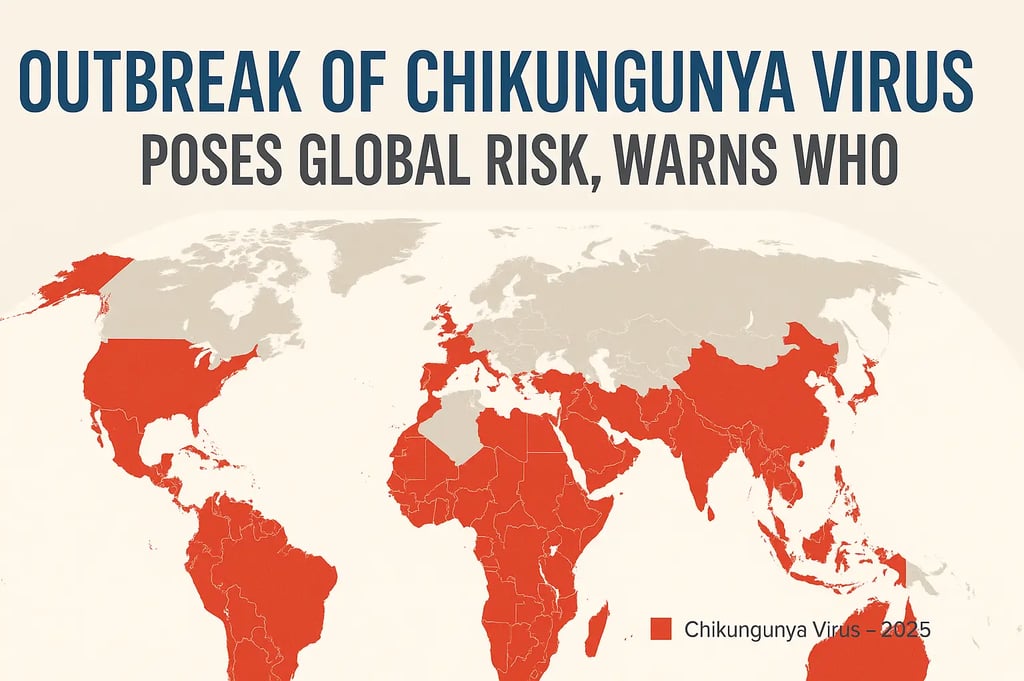Outbreak of Chikungunya Virus Poses Global Risk, Warns WHO
The World Health Organization warns that the Chikungunya virus outbreak could escalate into a global health threat. Learn about symptoms, transmission, global spread, and preventive measures.


Outbreak of Chikungunya Virus Poses Global Risk, Warns WHO
The World Health Organization (WHO) has issued a serious warning about the Chikungunya virus, highlighting its potential to become a global health emergency. Once considered a localized tropical disease, Chikungunya is now spreading at an alarming rate across various regions — including parts of Asia, Africa, Europe, and the Americas.
This recent surge in infections has prompted health experts worldwide to act quickly. In this article, we’ll explore what Chikungunya is, how it spreads, symptoms to watch for, regions most at risk, and crucial preventive measures everyone should know.
What is Chikungunya?
Chikungunya is a mosquito-borne viral infection caused by the Chikungunya virus (CHIKV). The name "Chikungunya" originates from a word in the Kimakonde language, meaning "to become contorted," referencing the stooped posture of those suffering from severe joint pain.
It is primarily transmitted by Aedes aegypti and Aedes albopictus mosquitoes, the same species responsible for spreading Dengue and Zika viruses.
Why is the WHO Alarmed?
The WHO's recent alert emphasizes that:
Chikungunya cases have been rising rapidly in multiple countries.
There’s an increased risk of cross-border transmission, especially in regions with tropical or subtropical climates.
The disease lacks specific antiviral treatments and commercial vaccines.
Urbanization, international travel, and climate change are contributing to the wider spread of vector-borne diseases like Chikungunya.
The WHO is urging governments and health systems to strengthen surveillance, educate communities, and improve vector control measures to prevent a potential global outbreak.
Global Spread and High-Risk Regions
Originally identified in Africa in the 1950s, Chikungunya was confined to limited outbreaks for decades. However, over the past 20 years, it has spread aggressively.
Countries With Notable Chikungunya Outbreaks in 2025:
India: States like Maharashtra, Kerala, and Tamil Nadu have reported thousands of cases.
Brazil: Widespread transmission in urban centers.
Thailand & Indonesia: Increase in infections due to favorable mosquito breeding conditions.
France & Italy: Imported cases and localized outbreaks during the summer season.
Caribbean Islands: Tourists and residents alike face increased risk.
Symptoms of Chikungunya
Chikungunya typically begins 3 to 7 days after a mosquito bite. While it's rarely fatal, the symptoms can be extremely debilitating.
Common Symptoms Include:
High fever (often > 102°F or 39°C)
Severe joint pain (can last for weeks or even months)
Muscle pain
Headache
Fatigue
Skin rash
Some patients may experience lingering joint inflammation, mimicking arthritis-like symptoms. In rare cases, complications may arise for newborns, elderly individuals, and those with pre-existing medical conditions.
Diagnosis and Treatment
There is no specific antiviral treatment for Chikungunya. Diagnosis is often based on symptom presentation and travel history, supported by blood tests to detect viral RNA or antibodies.
Treatment Options:
Rest
Hydration
Paracetamol or acetaminophen to relieve pain and fever (Avoid aspirin and NSAIDs due to risk of bleeding)
Anti-inflammatory medication for joint pain (under medical supervision)
Preventive Measures Against Chikungunya
With no vaccine currently approved, prevention is the best defense against Chikungunya. WHO and local health agencies strongly recommend the following steps:
1. Mosquito Control:
Eliminate stagnant water where mosquitoes breed (e.g., flower pots, gutters, open containers).
Spray insecticides in mosquito-prone areas.
2. Personal Protection:
Use mosquito repellents containing DEET, picaridin, or oil of lemon eucalyptus.
Wear long-sleeved clothing and pants, especially during early morning and late afternoon.
Install window and door screens to prevent mosquitoes from entering homes.
Sleep under mosquito nets, especially in areas with poor sanitation.
3. Community Action:
Participate in local clean-up drives.
Support government-led fogging and awareness campaigns.
Educate communities about identifying and eliminating mosquito breeding grounds.
Chikungunya vs. Dengue vs. Zika: Know the Difference
Though all three are transmitted by the same mosquito species, their symptoms and complications differ:
Understanding the distinction helps with early diagnosis and appropriate treatment.
WHO’s Global Strategy Against Vector-Borne Diseases
The WHO has launched a Global Arbovirus Initiative that targets multiple mosquito-borne illnesses including Chikungunya, Dengue, and Zika. The key pillars include:
Early detection and reporting
Emergency preparedness
Cross-border collaboration
Research on vaccines and treatment
Community engagement
As part of this, the WHO urges nations to invest in research and healthcare infrastructure to curb the global spread.
What You Can Do Right Now
Whether you're living in a high-risk area or planning to travel, here are immediate steps you can take:
Check regional alerts for mosquito-borne disease outbreaks.
Avoid peak mosquito hours or use protection if outdoors.
Consult your doctor if you experience unexplained fever or joint pain after travel.
Stay informed via trusted sources like the WHO, CDC, and your local health department.
Conclusion
The recent WHO alert about the global risk posed by the Chikungunya virus is not just a warning — it's a wake-up call. With cases rising worldwide, the need for collective awareness, prevention, and preparedness has never been more urgent.
By staying informed and taking proactive steps, individuals and communities can play a vital role in slowing the spread and protecting public health. As research continues into vaccines and treatments, the fight against Chikungunya will depend on global collaboration and local action.
👉 Related Post: Top Emergency Medicines You Should Have at Home
